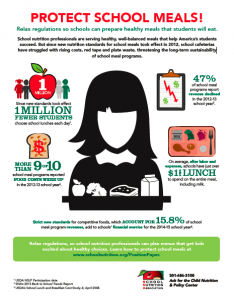School nutrition standards: the ongoing fight for healthier school meals
Union of Concerned Scientists food systems analysts Karen Stillerman and Lindsay Haynes-Maslow have issued firm rebuttals to the School Nutrition Association’s excuses for opposing nutrition standards for school meals.
- Excuse #1: There’s a shortage of whole grain Rice Krispies Treats
- Excuse #2: Healthier standards have driven up school food costs
- Excuse #3: Lowering sodium levels at school may harm kids *
- Excuse #4: Students won’t eat whole-grain rich foods*
- Excuse #5: Some schools are struggling to implement the new requirements
*These two are congressional targets (see below)
Dana Woldow explains what’s really happening with schools that drop out of the meal programs ostensibly on the grounds that the new standards cost too much.
Bettina Siegel explains how anti-standard campaigns play out in Texas:
Tucked within an Orwellian press release touting its efforts to “combat child obesity,” the Texas Department of Agriculture has made official its lifting of a decade-old ban on deep fat fryers in Texas schools, as well as rolling back other common sense school nutrition measures…despite the fact that our state ranks fifth in the nation for obesity among high school students, and despite public comments reportedly opposing the TDA’s plan by an astounding margin of 105 to 8.
USDA Secretary Tom Vilsack pleads with the School Nutrition Association to stop fighting the healthier school meal standards.
*But the House and Senate continue to roll back the standards for whole grains and salt in their respective versions of the Agriculture Appropriations Bills.*
- House Agricultural Appropriations Bill (see Sec. 732 and 733)
- Senate Agricultural Appropriations Bill (see Sec. 745)
If you are baffled as to why the School Nutrition Association would oppose healthier meals for the children they serve, consider the food company sponsors of that organization and how aggressively SNA courts food company sponsors. (But there’s a ray of hope. Maybe, Dana Woldow suggests, the new SNA President will put kids’ health first).
If you are baffled as to why healthier meals for school kids would induce Congress to try to undermine them, consider the companies that profit most from selling products that do not meet nutrition standards to America’s schools.
Maybe the President will veto? The White House Office of Management and Budget filed an objection:
The Administration strongly objects to using the appropriations process for objectionable language provisions that are wholly unnecessary to the operation of the nutrition programs and would impede efficient administration of the programs. For example, on whole grains, USDA has provided States and school districts with the flexibility they need now and would consider continuing that flexibility, if needed. However, the Administration opposes inclusion of this provision in the bill, as it signals that the
waivers are not dependent on the availability of reasonably priced whole grain options.
Let’s hope Congress removes these micromanaging provisions before sending the bill to the President.
*Addition: Ten reasons why Congress should stay out of school lunch.




